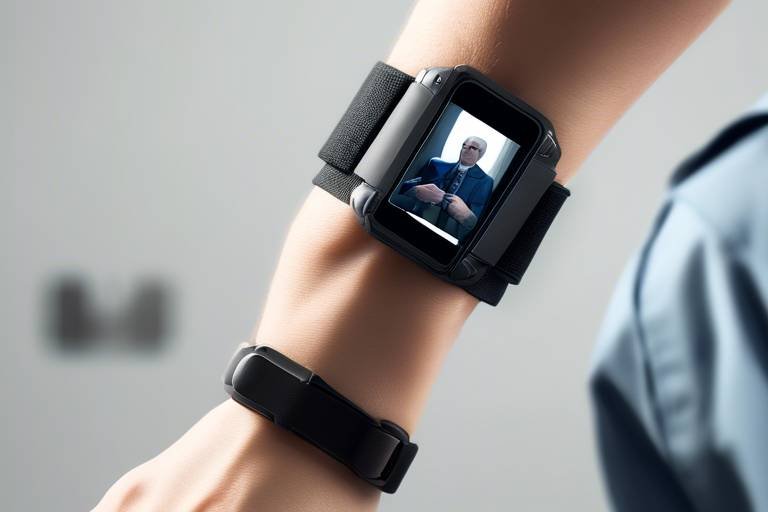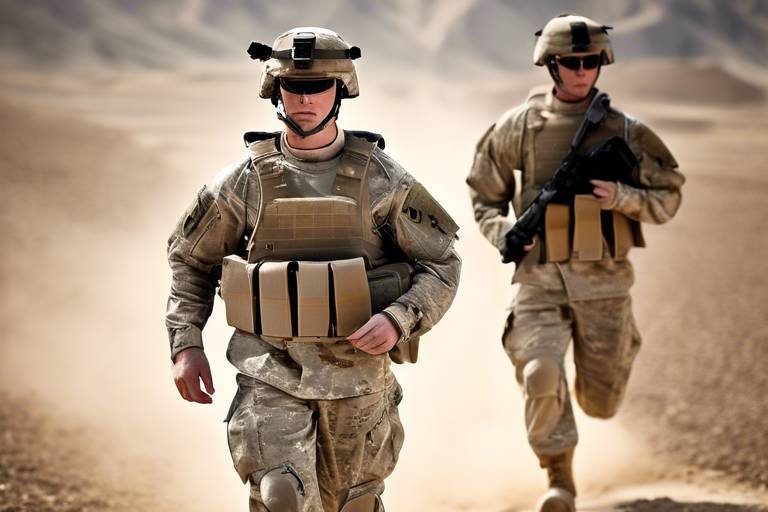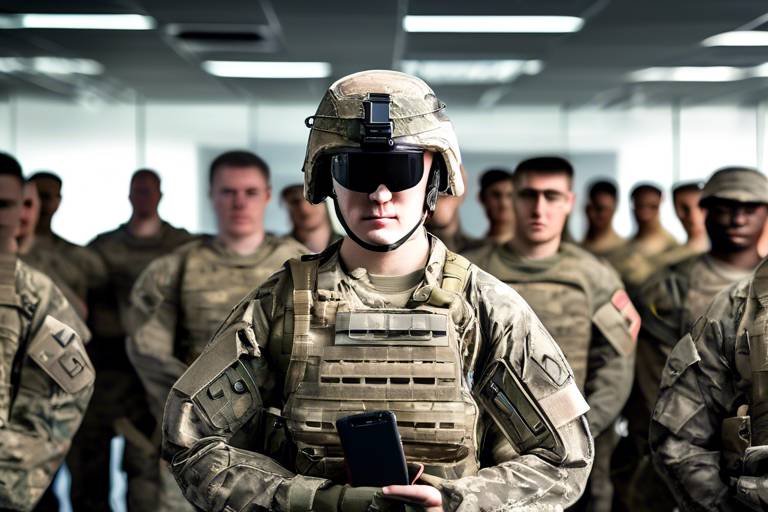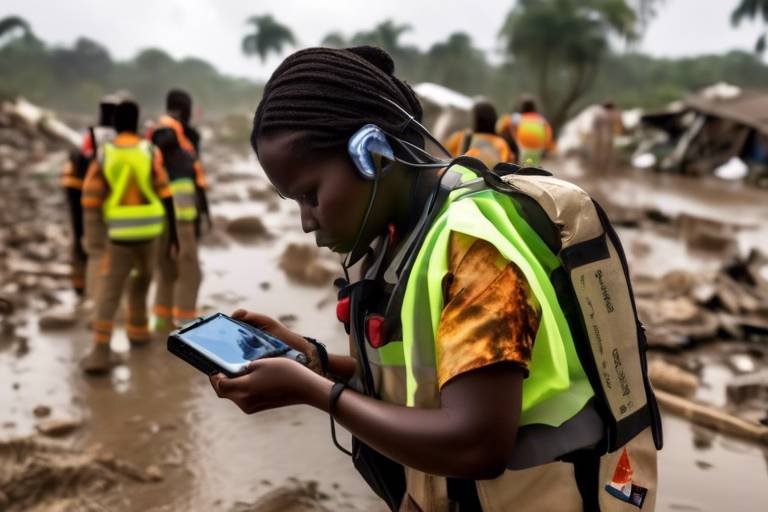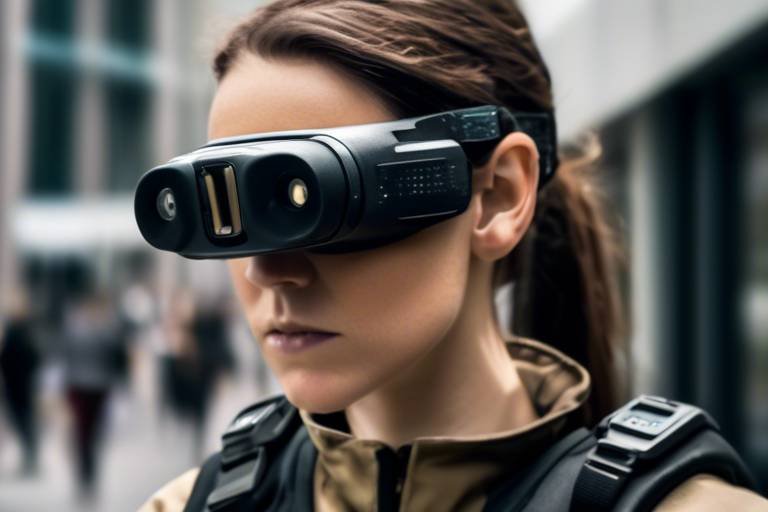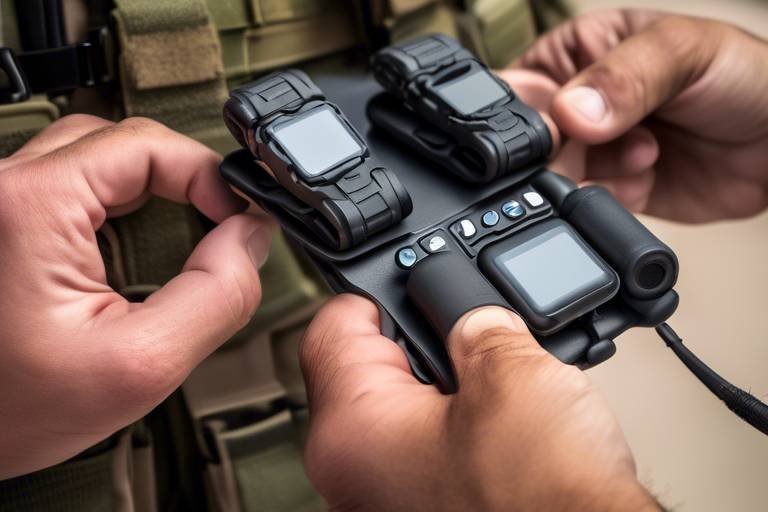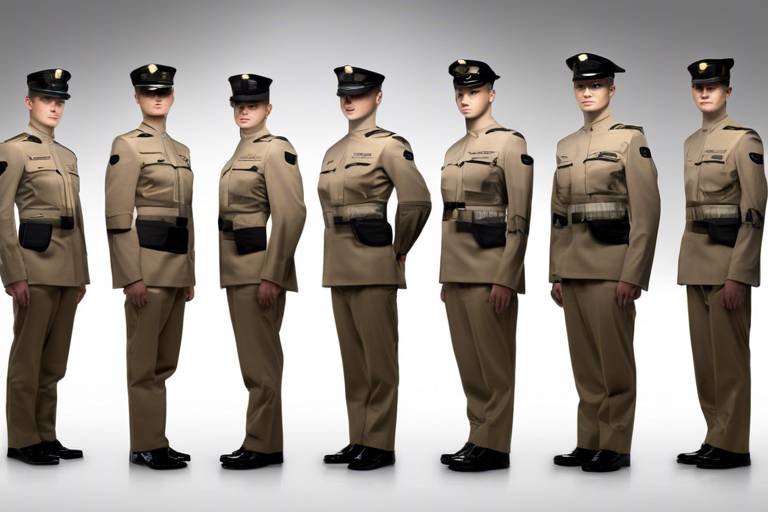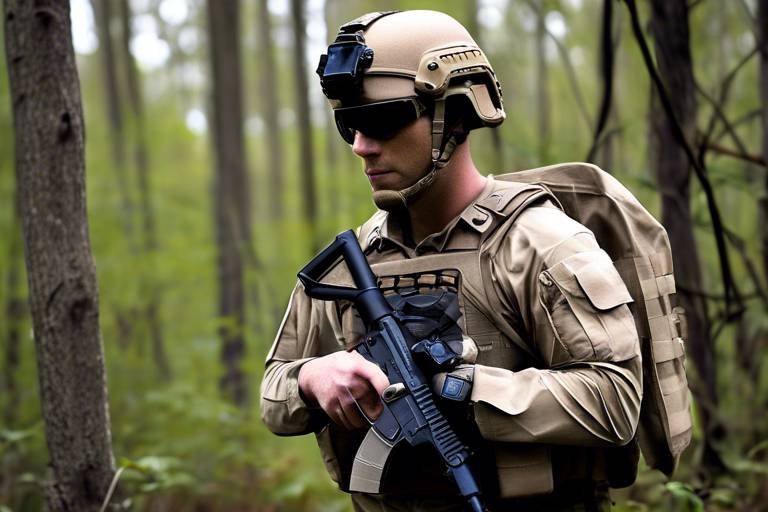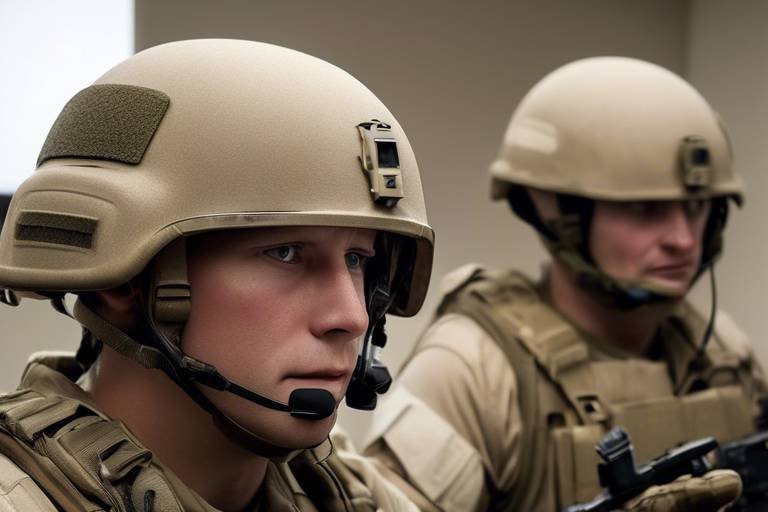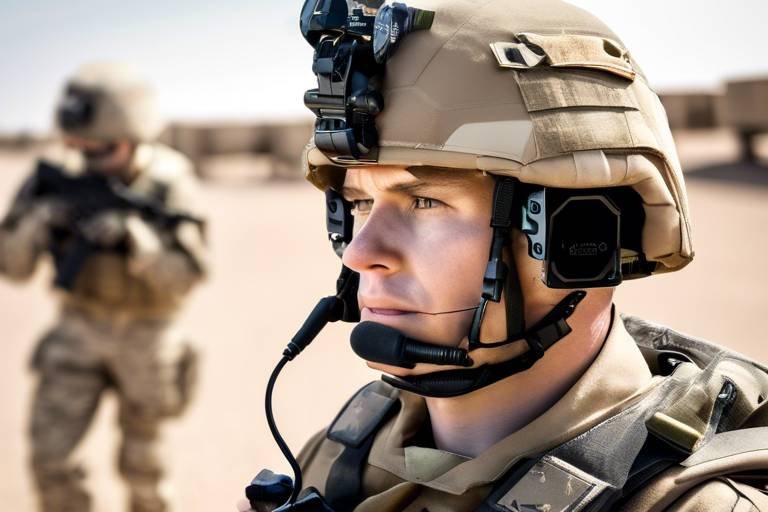How Wearable Devices Facilitate Effective Inter-Agency Cooperation
In today's fast-paced world, where every second counts, the integration of technology into our daily operations has never been more crucial. Wearable devices, often seen as gadgets for fitness enthusiasts, are now stepping into the limelight as powerful tools for enhancing collaboration among different agencies. Imagine a scenario where first responders, law enforcement, and emergency medical teams are all on the same page, sharing vital information instantaneously. This is not just a dream; it's becoming a reality thanks to the rise of wearable technology.
Wearable devices, such as smartwatches, fitness trackers, and specialized communication gear, have taken the world by storm. Their ability to provide real-time data and facilitate seamless communication is revolutionizing how agencies work together. When you think about it, these devices act like a digital Swiss Army knife, equipping personnel with the tools they need to respond quickly and effectively in critical situations. The beauty of wearables lies in their capacity to enhance operational efficiency, making them indispensable in collaborative efforts.
As we delve deeper into the role of wearables in inter-agency cooperation, it's essential to recognize the multifaceted benefits they bring. For starters, wearables improve communication by breaking down silos that often exist between agencies. Picture this: during a natural disaster, agencies are often scattered, each with its own communication protocols. Wearable technology bridges these gaps, allowing for quicker decision-making and more effective coordination. It's like having a direct line to every team member, ensuring that everyone is informed and ready to act.
Moreover, the power of real-time data sharing cannot be overstated. Wearables enable personnel to share critical information instantaneously, enhancing situational awareness. This means that whether it's tracking the location of first responders or monitoring environmental conditions, all agencies involved have access to the same vital information when it matters most. In essence, wearables transform how agencies interact, creating a more cohesive and responsive operational framework.
As we explore the rise of wearable technology, it's fascinating to see how these devices have evolved from simple health trackers to sophisticated tools capable of transforming inter-agency collaboration. The adoption of wearables in various sectors, including healthcare, law enforcement, and emergency management, highlights their versatility and effectiveness. These devices are not just trends; they are becoming standard practice in enhancing operational workflows.
Effective communication is the backbone of successful collaboration. Wearable devices facilitate this by allowing for seamless interaction between agencies. No longer do teams have to rely on outdated communication methods that can lead to delays and misunderstandings. With wearables, information flows freely and quickly, ensuring that every team member is on the same page. This is particularly crucial during joint operations or emergency responses, where timing can mean the difference between success and failure.
Let’s dive deeper into the concept of real-time data sharing. Imagine a scenario where a fire department, police force, and medical teams are all responding to a major incident. With wearables, they can share information such as personnel locations, resource availability, and situational updates instantly. This level of connectivity enhances situational awareness and ensures that all agencies involved are equipped with the information they need to make informed decisions.
Examining specific instances where wearable technology has improved inter-agency cooperation can provide valuable insights. For example, during a large-scale emergency drill, agencies that utilized wearables reported a significant increase in coordination efficiency. They could track personnel in real-time, monitor resource deployment, and communicate effectively across various units, leading to a more streamlined response.
However, it’s essential to address the challenges that come with this technological advancement. Despite the numerous benefits, issues like data security and compatibility between different agencies' systems can hinder effective communication through wearable devices. It's crucial for agencies to work collaboratively to address these challenges and ensure that the technology is used to its fullest potential.
Beyond communication, wearable devices can also play a significant role in training and preparedness. Agencies can use wearables to simulate real-world scenarios, allowing personnel to practice their responses in a controlled environment. This not only enhances individual skills but also fosters teamwork and collaboration, ensuring that everyone knows their role when it comes time to act.
In emergency situations, the impact of wearables can be profound. They streamline coordination among various agencies, improving response times and overall effectiveness of disaster management efforts. The ability to track personnel and resources in real-time ensures that help is dispatched where it is needed most, making the difference between life and death.
Wearable technology enables agencies to monitor the location of personnel and resources during emergencies. This real-time tracking capability ensures that every team member is accounted for and that resources are allocated effectively. In chaotic situations, having a clear picture of where everything is can be invaluable.
Finally, wearables provide valuable insights into performance and areas for improvement. After an operation, agencies can analyze data collected from wearables to refine their collaborative strategies. This feedback loop is essential for continuous improvement, ensuring that agencies learn from each experience and enhance their future responses.
- What types of wearable devices are commonly used by agencies?
Common devices include smartwatches, body cameras, GPS trackers, and health monitors. - How do wearables improve emergency response times?
Wearables facilitate instant communication and real-time data sharing, allowing for quicker decision-making. - What are the main challenges of implementing wearable technology?
Challenges include data security, compatibility issues, and the need for proper training on the devices. - Can wearables be used for training purposes?
Yes, they can simulate real-world scenarios to enhance preparedness and teamwork among agencies.
The Rise of Wearable Technology
In recent years, wearable technology has surged in popularity, transforming the way we interact with the world around us. From smartwatches to fitness trackers, these devices have become an integral part of our daily lives. But what does this mean for agencies that rely on effective collaboration? The answer lies in the incredible capabilities these devices offer. Imagine a world where critical information is at your fingertips, enabling you to make faster decisions and respond to emergencies with unprecedented efficiency. That's the power of wearable technology!
Wearable devices are not just trendy gadgets; they are powerful tools that provide real-time data and communication capabilities. This is particularly beneficial in sectors such as healthcare, law enforcement, and emergency services, where timely information can be a matter of life and death. For instance, consider a scenario where first responders are equipped with smart glasses that display vital statistics of a patient in need. This immediate access to information can significantly enhance the effectiveness of their response.
The rise of wearable technology is also fueled by advancements in sensor technology and wireless communication. These innovations allow wearables to collect and transmit data seamlessly, creating a network of interconnected devices. This interconnectedness is crucial for agencies that must work together during emergencies. By sharing information instantly, agencies can coordinate their efforts more effectively, ensuring that resources are utilized optimally.
However, the impact of wearable technology extends beyond just real-time data sharing. These devices can also improve operational efficiency by automating routine tasks. For example, law enforcement officers can use wearable cameras to record interactions, which not only provides transparency but also frees them up to focus on more pressing matters. This shift in focus can lead to improved outcomes in joint operations, making collaboration smoother and more effective.
As we look to the future, the potential for wearable technology in enhancing inter-agency cooperation is immense. The integration of artificial intelligence and machine learning into these devices could pave the way for even more sophisticated applications. Picture wearables that can predict potential issues based on historical data, allowing agencies to proactively address challenges before they escalate. The possibilities are truly exciting!
In summary, the rise of wearable technology is reshaping the landscape of inter-agency collaboration. With their ability to provide real-time data, enhance communication, and improve operational efficiency, wearables are not just a trend—they are a vital component of modern agency operations. As we continue to embrace these innovations, the future of effective collaboration looks brighter than ever.
Improving Communication Among Agencies
In today's fast-paced world, effective communication is the backbone of any successful operation, especially when it comes to inter-agency collaboration. Wearable devices are revolutionizing the way agencies communicate, breaking down barriers and fostering a culture of teamwork. Imagine a scenario where first responders, law enforcement, and medical teams can share critical information in real-time, all thanks to a small device strapped to their wrists. This is not just a dream; it’s a reality that wearable technology is making possible.
One of the standout features of wearables is their ability to enable seamless communication. These devices can send and receive messages, alerts, and notifications instantly, ensuring that everyone involved is on the same page. For instance, during a natural disaster, a firefighter equipped with a wearable can receive live updates about the location of victims, the status of other responders, and changing environmental conditions. This level of communication can significantly reduce response times and improve the overall effectiveness of the operation.
Moreover, the integration of wearable technology into communication systems allows for improved situational awareness. By wearing devices that can track various metrics—such as heart rate, location, and environmental data—agencies can gather and share vital information without the need for cumbersome equipment. This real-time data sharing is crucial, particularly in high-stakes situations where every second counts. For example, a police officer in the field can relay information about a suspect's location to a nearby unit, facilitating a quicker response and minimizing risks.
However, it's important to highlight that while wearables enhance communication, they also come with their own set of challenges. Agencies must address issues such as data security and the compatibility of different systems. To ensure that sensitive information remains protected, agencies need to implement robust security measures and protocols. Additionally, the diversity of technologies used by different agencies can lead to compatibility issues, making it essential to establish standardized communication protocols.
To illustrate the effectiveness of wearable devices in improving communication, let’s look at a few case studies. In a recent joint operation involving fire and rescue teams, the use of smart helmets equipped with communication systems allowed for real-time video feeds and voice communication. This not only improved coordination but also enhanced safety, as team members could see and hear each other clearly, even in the chaos of an emergency.
As we move forward, the potential for wearable technology to further improve inter-agency communication is immense. Innovations such as augmented reality (AR) and artificial intelligence (AI) could soon be integrated into these devices, providing even richer data and enhancing decision-making capabilities. The future is bright, and as agencies continue to embrace these technologies, we can expect to see even greater improvements in collaboration and efficiency.
Real-Time Data Sharing
In today's fast-paced world, the ability to share real-time data is not just a luxury; it's a necessity, especially when it comes to inter-agency cooperation. Imagine a scenario where multiple agencies are responding to a natural disaster. Each agency has its own set of tools and data, but without a seamless way to share that information, they might as well be speaking different languages. This is where wearable technology comes into play, acting as a bridge that facilitates smooth communication and data exchange.
Wearable devices, such as smartwatches or body cameras, can collect and transmit data instantaneously, ensuring that every agency involved has access to the same critical information at the same time. This capability enhances situational awareness—a term that refers to the understanding of what is happening around you. For instance, if a fire department is battling a blaze, they can use wearables to share real-time updates on the fire's spread, while police units can relay information about crowd control. This interconnectedness can significantly improve the effectiveness of their joint efforts.
Moreover, the data collected through wearables can include everything from geographical information to health metrics of personnel on the ground. This data can be aggregated into dashboards that provide a holistic view of the situation, allowing for quicker, more informed decision-making. For example, during a large-scale emergency, a command center can monitor the locations of all responders, assess their health status, and allocate resources accordingly. This not only speeds up response times but can also save lives.
However, the implementation of real-time data sharing through wearables is not without its challenges. Issues such as data security and compatibility between different systems can pose significant hurdles. Agencies must ensure that the data being shared is secure and that only authorized personnel have access to sensitive information. Furthermore, interoperability between different wearable devices and agency systems is crucial; otherwise, the flow of information may be hindered. To address these challenges, agencies can develop standardized protocols and invest in secure communication channels.
In conclusion, the ability to share real-time data through wearable technology is a game-changer for inter-agency cooperation. By enhancing situational awareness and facilitating informed decision-making, wearables are paving the way for more effective and coordinated responses in critical situations. As technology continues to evolve, we can expect even more innovative solutions that will further enhance the capabilities of agencies working together.
- What types of data can wearables collect? Wearables can collect a variety of data, including location, health metrics, and environmental conditions, which can be crucial during emergencies.
- How do agencies ensure data security? Agencies implement encryption and secure communication protocols to protect sensitive information shared through wearable devices.
- Can different agencies use different wearable devices? Yes, but for effective real-time data sharing, it's essential that the devices are compatible or that standardized protocols are established.
- What are the benefits of real-time data sharing? It enhances situational awareness, speeds up decision-making, improves coordination, and ultimately leads to more effective emergency responses.
Case Studies of Successful Implementations
When it comes to the real-world application of wearable technology in enhancing inter-agency cooperation, several notable case studies stand out, showcasing the transformative power of these devices. One prime example is the collaboration between emergency services during natural disasters. In a recent hurricane response, various agencies, including fire departments, police, and medical teams, utilized wearable devices that allowed them to share real-time data on weather conditions, resource availability, and personnel locations. This seamless communication not only improved situational awareness but also ensured that resources were deployed effectively, minimizing response times and saving lives.
Another compelling case study involves the use of wearables in law enforcement agencies across cities. During joint operations, officers from different jurisdictions equipped with smart glasses were able to share live video feeds and critical information with their command centers. This technology enabled them to make quicker decisions in high-pressure situations, such as hostage scenarios or active shooter incidents. The integration of wearable tech facilitated a level of coordination that was previously unattainable, allowing for a more unified response and ultimately leading to successful resolutions.
Moreover, in the realm of public health, agencies have leveraged wearable devices to monitor and manage the spread of infectious diseases. For instance, during a recent outbreak, health officials utilized wearables to track the movements and health data of healthcare workers and volunteers. This data was then shared among various agencies to ensure that those at risk received immediate support, and to track the effectiveness of containment measures. The ability to access real-time health metrics not only improved the response to the outbreak but also provided valuable insights for future public health initiatives.
These case studies highlight the potential of wearable technology to bridge gaps between agencies, fostering a collaborative environment that enhances overall effectiveness. However, they also underscore the importance of establishing best practices and protocols to maximize the benefits of such technology. By examining these successful implementations, agencies can learn valuable lessons about integrating wearables into their operations, ensuring that they are prepared for the challenges of tomorrow.
- What types of wearable devices are commonly used by agencies?
Wearable devices can range from smartwatches and fitness trackers to specialized equipment like smart glasses and body cameras. Each type serves different purposes, from tracking health metrics to providing real-time data sharing capabilities. - How do wearables enhance communication during emergencies?
Wearables facilitate instant communication by allowing agencies to share critical information in real-time, which is essential for coordination during emergencies. - What are some challenges faced when implementing wearable technology?
Challenges include data security concerns, compatibility issues between different systems, and the need for proper training to ensure effective usage of the devices. - Can wearable technology improve training for agency personnel?
Absolutely! Wearables can simulate real-world scenarios, allowing personnel to practice emergency responses and improve their readiness for collaborative efforts.
Challenges in Communication
While wearable devices bring a revolutionary shift in how agencies communicate and collaborate, they are not without their challenges. One of the primary hurdles is data security. With sensitive information being transmitted in real-time, agencies must ensure that their data is protected against potential breaches. Imagine a scenario where critical information falls into the wrong hands during a disaster response—this could lead to disastrous outcomes.
Another significant challenge is the compatibility of different systems used by various agencies. Each agency may utilize different technologies or platforms, leading to potential communication breakdowns. This is akin to trying to connect a puzzle piece that simply doesn’t fit; the result is frustrating and ineffective. For seamless collaboration, agencies must invest in systems that can interoperate effectively, which often requires time, resources, and strategic planning.
Moreover, the training of personnel on how to effectively use these wearable devices is crucial. If users are not adequately trained, the technology can become more of a hindrance than a help. For instance, if first responders are unfamiliar with the features of their wearables, they might miss critical alerts or fail to utilize the data being shared. This scenario highlights the importance of ongoing training and support.
Lastly, there is the issue of user acceptance. Some personnel may be resistant to adopting new technologies, preferring traditional methods of communication. This resistance can stem from a lack of understanding of the technology's benefits or simply a fear of change. To overcome this, agencies must engage in comprehensive outreach, demonstrating the tangible advantages of wearables in real-world scenarios.
In summary, while wearable technology offers immense potential for enhancing inter-agency communication, these challenges must be addressed head-on. By focusing on security, compatibility, training, and user acceptance, agencies can pave the way for a more connected and responsive collaborative environment.
- What are wearable devices?
Wearable devices are technology items that can be worn on the body, such as smartwatches, fitness trackers, and smart glasses, designed to provide functionality like health monitoring, communication, and data sharing.
- How do wearable devices improve communication?
They enable real-time data sharing and communication among agencies, allowing for quicker decision-making and enhanced situational awareness during operations.
- What are the main challenges of using wearable technology?
Challenges include data security, compatibility between systems, the need for adequate training, and user acceptance of new technology.
- Can wearables be used in emergency situations?
Yes, they can streamline coordination, track personnel and resources, and improve overall response effectiveness in emergencies.
Enhancing Training and Preparedness
In today's fast-paced world, the ability to adapt and prepare for unforeseen circumstances is crucial. Wearable devices are revolutionizing how agencies approach training and preparedness, transforming traditional methods into dynamic, real-world simulations. Imagine a scenario where first responders, police officers, and emergency medical teams can train together in a virtual environment that mimics the chaos of an actual emergency. This is not just a futuristic dream; it’s happening now!
By integrating wearable technology into training programs, agencies can create immersive experiences that enhance learning and retention. For instance, wearable sensors can monitor heart rates, stress levels, and physical exertion, providing immediate feedback to participants. This data allows trainers to tailor exercises to individual needs, ensuring that every participant is adequately challenged and prepared for real-life situations.
Moreover, the ability to simulate high-pressure scenarios using wearables helps agencies identify gaps in their preparedness. When agencies train together, they can evaluate their response times and communication effectiveness. For example, if a police officer and a paramedic are both equipped with wearables during a joint training exercise, they can share real-time data on their actions and decisions. This collaboration not only fosters teamwork but also highlights areas for improvement.
In addition to enhancing training, wearables can also facilitate continuous learning. Agencies can record training sessions and analyze performance metrics over time. This ongoing assessment helps refine training programs, ensuring that they remain relevant and effective. Imagine having a digital archive of training sessions that can be revisited and analyzed to enhance future preparedness efforts. The potential for growth and improvement is immense!
However, it's essential to address the challenges that come with implementing wearable technology in training. Agencies must ensure that all personnel are comfortable using these devices and that they understand the importance of the data being collected. Training on how to use the technology effectively is vital. Additionally, agencies need to establish protocols for data security to protect sensitive information gathered during training exercises.
As we look to the future, the integration of wearable technology in training and preparedness will likely become more sophisticated. We can expect advancements in augmented reality (AR) and virtual reality (VR) that will further enhance the training experience. Imagine training exercises where participants can visualize data overlays in real-time, making informed decisions quickly and efficiently. This level of engagement can significantly boost confidence and readiness among personnel.
In summary, wearable devices are not just gadgets; they are powerful tools that enhance training and preparedness across various agencies. By leveraging real-time data and immersive simulations, agencies can ensure that their personnel are not only trained but also ready to respond effectively when it matters most.
- How do wearable devices improve training outcomes? Wearable devices provide real-time feedback, allowing trainers to tailor exercises to individual needs and enhance learning.
- What types of data can wearables collect during training? Wearables can track heart rates, stress levels, physical exertion, and other vital metrics to assess performance.
- Are there privacy concerns with using wearable technology? Yes, agencies must establish protocols for data security to protect sensitive information collected during training.
- How can agencies ensure personnel are comfortable using wearables? Providing comprehensive training on how to use the devices effectively is crucial for comfort and confidence.
Impact on Emergency Response
In today's fast-paced world, where every second counts, the role of wearable technology in emergency response cannot be overstated. Imagine a scenario where multiple agencies are responding to a natural disaster, each equipped with wearable devices that not only keep them connected but also provide vital information in real-time. This is not just a futuristic dream; it's happening right now! Wearables are revolutionizing the way agencies collaborate during emergencies, making operations smoother and more efficient.
One of the most significant impacts of wearables is their ability to streamline coordination among various agencies. When disaster strikes, the chaos can be overwhelming. However, with wearable technology, agencies can communicate instantly, ensuring that everyone is on the same page. For example, if a fire breaks out in a building, firefighters can immediately share their location and status with police and medical teams, allowing for a well-coordinated response. This level of communication can drastically reduce response times, potentially saving lives.
Moreover, the tracking capabilities of wearable devices are game-changers. Agencies can monitor personnel and resources in real-time, ensuring that help is dispatched where it's needed most. For instance, during a large-scale evacuation, wearables can help track which areas have been covered and where additional resources are required. This not only enhances operational efficiency but also ensures that no one is left behind in critical situations.
| Benefits of Wearable Technology in Emergency Response | Examples |
|---|---|
| Real-Time Communication | Instant updates between agencies during a disaster |
| Personnel Tracking | Monitoring the location of responders in real-time |
| Resource Management | Efficient allocation of supplies and personnel |
| Data Collection | Gathering insights for post-incident analysis |
Another critical aspect is the feedback and performance monitoring that wearables provide. These devices can collect data on how agencies respond during emergencies, offering insights into what worked well and what didn’t. This information is invaluable for refining collaborative strategies for future incidents. By analyzing this data, agencies can improve their preparedness and response plans, ensuring they are better equipped for the next challenge.
However, while the benefits are clear, implementing wearable technology in emergency response does come with its challenges. Issues such as data security and the compatibility of different systems among agencies can create hurdles. It's crucial for agencies to address these challenges proactively to fully leverage the potential of wearables in crisis situations.
In conclusion, the impact of wearable technology on emergency response is profound and multifaceted. As agencies continue to adopt these innovative tools, the future looks promising. With enhanced communication, real-time tracking, and valuable performance insights, wearable devices are not just accessories; they are essential components of modern emergency response strategies.
- How do wearable devices enhance communication during emergencies? Wearable devices enable instant communication between agencies, allowing for quicker decision-making and coordinated responses.
- Can wearables help in tracking personnel during a disaster? Yes, wearables can track personnel in real-time, ensuring that help is dispatched where it is needed most.
- What are the challenges of using wearables in emergency response? Challenges include data security concerns and compatibility issues between different agencies' systems.
- How can data from wearables improve future emergency responses? Data collected from wearables can provide insights into performance and areas for improvement, helping agencies refine their strategies.
Tracking Personnel and Resources
In today's fast-paced world, the ability to track personnel and resources in real-time has become a game-changer for agencies involved in emergency response and collaborative efforts. Imagine a scenario where multiple agencies, such as fire departments, medical teams, and law enforcement, are working together during a natural disaster. The chaos can be overwhelming, but with wearable technology, agencies can maintain a clear line of sight on their personnel and the resources at their disposal. This capability not only enhances safety but also optimizes the efficiency of the entire operation.
Wearable devices equipped with GPS and other tracking technologies allow agencies to monitor the location of their team members as well as essential equipment. This real-time tracking provides a significant advantage in emergency situations where every second counts. For instance, if a rescue team is deployed to a specific location, the command center can instantly see where each team member is, ensuring that help is directed where it is most needed. This level of situational awareness can drastically reduce response times and improve overall effectiveness.
Moreover, the data collected from these wearables can be invaluable for post-operation analysis. Agencies can review the tracking data to assess how resources were utilized, where delays occurred, and how personnel moved throughout the operation. This feedback loop allows for continuous improvement in strategies and tactics for future collaborations. The insights gained can lead to better training programs and refined operational protocols, ultimately enhancing the agency's readiness for future emergencies.
However, it’s essential to address the privacy concerns that come with tracking personnel. Agencies must ensure that the data collected is used responsibly and that personnel are informed about how their information will be utilized. Balancing the need for real-time tracking with the right to privacy is crucial for maintaining trust among team members.
In conclusion, the integration of wearable technology for tracking personnel and resources not only enhances operational efficiency but also fosters a culture of safety and preparedness. As technology continues to evolve, we can expect even more sophisticated solutions that will further improve inter-agency cooperation in times of crisis.
- What types of wearable devices are commonly used for tracking? Wearable devices like smartwatches, GPS-enabled badges, and fitness trackers are commonly used for tracking personnel and resources.
- How does real-time tracking improve emergency response? Real-time tracking allows agencies to monitor the location of personnel and resources, ensuring quick decision-making and efficient resource allocation during emergencies.
- Are there privacy concerns associated with tracking personnel? Yes, privacy concerns exist, and agencies must implement policies to protect personnel data and inform them about how their information is used.
- Can tracking data be used for training purposes? Absolutely! Tracking data provides insights that can help agencies refine their training programs and improve future collaborative efforts.
Feedback and Performance Monitoring
In the fast-paced world of inter-agency collaboration, play critical roles in ensuring that all parties involved are operating at their best. Wearable devices have revolutionized how agencies can gather and analyze performance data, providing real-time insights that can significantly enhance operational efficiency. Imagine being able to track not just the location of personnel but also their physiological responses during high-stress situations. This is precisely what wearables bring to the table.
Through the integration of wearables, agencies can collect a wealth of data that includes everything from heart rates to movement patterns. This information is invaluable, especially in emergency scenarios where understanding the physical and emotional state of team members can lead to better decision-making. For example, if a first responder's heart rate spikes, it could indicate a need for immediate support or a change in strategy. Such real-time feedback allows for a dynamic response to evolving situations, ultimately saving lives and resources.
Moreover, the data collected from wearables can be analyzed to identify trends and areas for improvement. Agencies can monitor performance metrics over time, allowing them to refine their training programs and operational strategies. For instance, if data shows that a particular agency struggles with communication during joint operations, targeted training can be developed to address these weaknesses. This kind of proactive approach not only enhances individual agency performance but also strengthens the overall effectiveness of collaborative efforts.
However, it’s not just about collecting data; it’s about interpreting it effectively. Agencies must invest in data analytics tools and training to ensure that the information gathered from wearables is used to its fullest potential. This means having personnel who can sift through the data, extract actionable insights, and communicate these findings to all stakeholders involved. Without this step, the data remains just numbers on a screen, devoid of the impact it could have on inter-agency cooperation.
Furthermore, agencies can establish feedback loops that encourage continuous improvement. Regular debriefings that incorporate wearable data can help teams understand what worked well and what didn’t during joint operations. By fostering an environment where feedback is not only welcomed but actively sought after, agencies can cultivate a culture of learning and adaptation. This is essential in a landscape that is continually evolving, especially in the face of new technologies and emerging threats.
To summarize, the integration of wearable devices into inter-agency operations offers a robust framework for feedback and performance monitoring. By leveraging real-time data and fostering a culture of continuous improvement, agencies can enhance their collaborative efforts, ensuring they are better prepared for whatever challenges may arise. The future of inter-agency cooperation is undoubtedly linked to how effectively we can utilize technology to monitor and improve our performance.
- How do wearable devices enhance communication between agencies?
Wearable devices facilitate real-time communication, allowing for instant sharing of critical information, which is vital during emergencies. - What types of data can wearables collect?
Wearables can track a variety of data, including location, heart rate, movement patterns, and even environmental conditions. - How can agencies ensure data security when using wearables?
Agencies should implement robust cybersecurity measures, including encryption and strict access controls, to protect sensitive data. - Can wearables be used for training purposes?
Yes, wearables can simulate real-world scenarios, allowing agencies to train in a controlled environment while still gathering valuable performance data. - What are the challenges of integrating wearables into existing systems?
Challenges include compatibility issues, data security concerns, and the need for personnel training on new technologies.
Frequently Asked Questions
- What are wearable devices and how do they enhance inter-agency cooperation?
Wearable devices are tech gadgets that can be worn on the body, like smartwatches or fitness trackers. They enhance inter-agency cooperation by providing real-time data and communication capabilities, which streamline operations and improve collaboration during joint efforts or emergencies.
- How do wearables improve communication among different agencies?
Wearables facilitate seamless communication by allowing agencies to share information instantly. This quick access to data leads to faster decision-making and better coordination, especially vital during critical situations like emergency responses.
- What challenges do agencies face when using wearable technology?
While wearables offer many benefits, agencies often encounter challenges such as data security issues and compatibility problems between different systems. These hurdles can limit the effectiveness of communication and data sharing.
- Can wearable devices be used for training purposes?
Absolutely! Wearable devices can simulate real-world scenarios for training, helping agencies prepare for collaborative efforts. This hands-on approach enhances readiness and ensures personnel are well-equipped to handle actual situations.
- How do wearables impact emergency response efforts?
In emergencies, wearable technology plays a crucial role by improving coordination among agencies. It helps track personnel and resources in real-time, ensuring that assistance is dispatched efficiently and effectively when needed most.
- What insights do wearables provide for performance monitoring?
Wearables provide valuable feedback regarding personnel performance and collaboration strategies. By analyzing this real-world data, agencies can identify areas for improvement and refine their approaches to enhance overall effectiveness.

